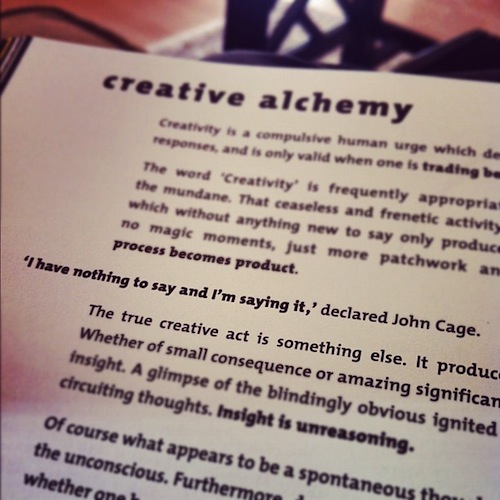A couple of weeks ago I read this quote by John Cage in The Art of Looking Sideways:

I have nothing to say and I’m saying it. Is your mind racing about all the ways that statement applies to life on the Internet? Yeah, me too. In fact, the phrase immediately made me think of a joke I could make on Twitter, which I wrote down right away. But I wanted to get my facts right, so I started reading up on John Cage – as you do when you’re on vacation. This is where I ask you to please stick with me as we go on a brief detour about the nature of criticism.
My rabbit-hole journey into the world of John Cage led me to a great 2004 essay by Joe Dacey called John Cage Defined in the 1950s. It outlines how the phrase “I have nothing to say and I’m saying it” comes from his “Lecture on Nothing”:
In this lecture, he outright tells the listener that the lecture has no point and will go nowhere, “I am here and there is nothing to say. If among you are those who wish to get somewhere, let them leave at any moment”. He implores the audience to enjoy each and every moment of the lecture even though he admits that it is pointless. He advocates that, “Our poetry now is the realization that we possess nothing. Anything therefore is a delight (since we do not possess it) and thus need not fear its loss” and “It is not irritating to be where one is. It is only irritating to think one would like to be somewhere else”.
It’s not just you – that is a weird thing to do. What fascinates me most about Cage is that he never bothered to reflect on any criticism of his work. Ever.
Cage mostly ignored criticism he received believing that most people didn’t understand why he composed the music he composed. In fact, he saw society as “one of the greatest impediments an artist can possibly have” to creating good art. After receiving a review for a concert he gave in Seattle that stated the performance was “ridiculous,” Cage’s responded that he had no interest in the review because he “knew perfectly well it wasn’t.”
Knowing when to ignore criticism and when to listen to it is one of the hardest skills to learn, and so easy to get wrong. On the one extreme is the John Cage approach, where you view all criticism as bogus or not worthy of your attention. On the other extreme there are people (and companies) who change course with every little piece of feedback they get, regardless of its merit.
But somewhere in between is a happy medium where you use criticism as a springboard to ask yourself tough questions. If you’re a designer, those questions might be things like, “Why did I put this button here?” or “Why might someone find this interface confusing?”. Those are excellent questions to ask yourself. If you can answer them, and defend the decisions you made, you can move on to the next thing. If your questions lead you to make some changes, well, that’s great too because your end result is going to be a better product.
I like the way The 99 Percent approaches the process of finding this middle ground in their article On Criticism, Cynicism & Sharpening Your Gut Instinct:
Criticism is doubt informed by curiosity and a deep knowledge of a discipline related to your work. Whether the criticism you receive is constructive or not, it comes from knowledge. Informed insights like “I’m not sure someone would ever pay that much” or “you may not want to outsource that given the high-touch required” may cause you to question your approach.
By contrast, cynicism is a form of doubt resulting from ignorance and antiquated ways. Industry experts will often express doubt based on an ingrained muscle memory of past experiences that handicaps their vision for the future. Cynical statements like, “People will never read a book on a computer” or “Why would anyone want to put their rolodex online?” are famous doubts expressed by experts with handicapped vision.
Their advice is simple: Savor criticism, shun cynicism. That seems like a sound approach to me.
Anyway, I mention all of this to ensure you of the accuracy of the joke I ended up making:
“I have nothing to say and I am saying it” – John Cage in his 1949 lecture on posting Foursquare check-ins to Twitter
— Rian van der Merwe (@RianVDM) May 14, 2012
You are, of course, welcome to disagree and send me your criticism.